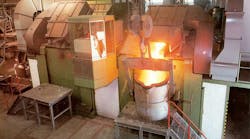Maintaining Furnace Efficiency Saves Energy, Minimizes Utility Costs
The latest generation of furnaces used in metalcasting can be models of efficiency. But that efficiency can be compromised quickly, costing more energy in the melt shop. However, there are several things you can do to preserve much of that efficiency.
It’s no secret that melt shop operations account for a majority of your electric bill, and the cost of energy has risen considerably. Indeed, costs are projected to keep rising for a number of reasons. Making your melting operations as efficient as possible will help to minimize future energy costs.
Furnace efficiency can be degraded by both insulation and operational causes. Let’s consider the insulation issue first.
Furnace insulation is usually a good thing, keeping heat or cold where it should be. But an inadvertent build-up of slag on interior walls can act as an efficient insulator between the heating elements of the furnace and the raw materials you are trying to melt. Slag build-up effectively increases the thickness of the refractory in the furnace and decreases the efficiency of the energy being applied to melt the charge material. The thicker the slag, the longer it will take to melt the material.
Significant build-up can occur in as little as 48 hours of operation, and this requires additional energy (25% or more), resulting in a higher utility bill.
Recently I was reminded of products from ASI International that are designed to greatly reduce the amount of slag produced during melting. In the past, refractory manufacturers have discouraged the use of fluxes in ferrous foundries, but new developments in flux chemistry (such as those offered by ASI) allow for flux use in furnaces lined with dry vibratable silica refractories.
Of course, another benefit of limiting slag build-up is that furnace refractories do not have to be maintained as often. The furnace is operational longer and uses less energy.
Operational issues may exist that can also result in higher energy bills. Some issues are hiding in plain sight, while others are stealthier. Simple things like not closing furnace covers to retain heat is one of those hiding in plain sight. Closing the covers will reduce both the energy bill and the time needed to melt the batch, effectively improving throughput. Have a walkabout through the foundry; you may see other opportunities for savings.
Some savings opportunities can be harder to find. Such stealthier opportunities may be discovered by investing in some inexpensive monitoring technology, to continuously record how much energy is consumed by the device in question. One technology (costing less than $1,000) can record energy consumption for several furnaces every 3 seconds and record its readings for years. Analysis of the raw data provided can be very useful.
An example is furnace settings by different operators. A wide variation in energy requirements can result from relatively minor changes in furnace settings – during both melting and holding stages. Data analysis can identify the most efficient operators and best practices can be shared with everyone. Best of all, a continuous improvement program can be implemented to further refine the melting process. Lower utility bills and higher throughput can be achieved and maintained.
There may be another stealthy opportunity in how you utilize your holding furnaces. Special products may be held in holding furnaces for extended periods, just in case they are needed. But how long is too long? When does the energy cost outweigh the benefit of having the product immediately available? Comparing energy cost to the production schedule may result in some significant energy savings. Asset utilization and throughput may also be improved.
Going parabolic. With utility bills on a parabolic trajectory, this would be a good time to revisit how you can optimize your furnace operations. Thankfully, there are products and services to help you find solutions and major savings.
Brian Reinke, president of TDI Consulting, is an energy-cost saving consultant. Contact him at [email protected] for a customized, no-obligation quote to review your electric system.
About the Author
Brian Reinke
President
Brian Reinke, president of TDI Energy Solutions, is an energy-cost saving consultant. Contact him at 630-343-0971.
